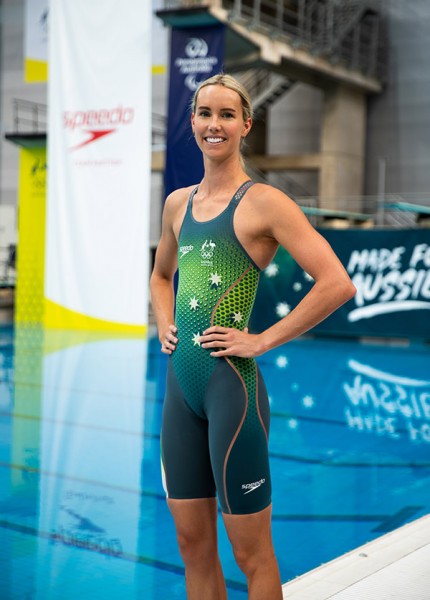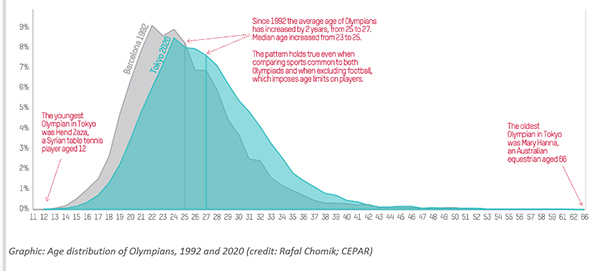Study provides insights into the peak performance age in sport

The ARC Centre of Excellence in Population Ageing Research has released a fact sheet on peak performance age in sport which analyses the age at which athletes are competing at their best and how the typical age has changed over time. The study provides insights about how human abilities change with advancing years and how this plays out in the careers of elite athletes as well as recreational athletes in community sport.
Estimating peak physical performance by age
There are different ways of estimating peak physical performance outcomes, including by looking at world records by age or tournaments won. The new ARC Centre of Excellence in Population Ageing Research (CEPAR) study looks at participation at the top level, in both the Olympics and in professional sport, and brings together existing literature and the latest data to illustrate the optimal ages at which physiology, training, and strategy combine for different sports, for both men and women, and how this is changing over time.
Rafal Chomik, lead author and a CEPAR Senior Research Fellow at the UNSW Business School notes “Athletes in sports requiring speed and power tend to peak by their mid-20s, those in endurance sports peak by their 40s, while those in tactical, low impact sports can still compete at elite level at more advanced ages.
“This is consistent with findings on cognitive capacity: young people are better at tasks requiring raw processing power while older people excel at strategy.”
Age differs within sport
The latest Olympics have provided ample evidence of these patterns. Analysing the age of Olympians by sports and gender, the study found that athletes in sports relying on speed, flexibility and maximal oxygen consumption, such as swimming, had the lowest ages, with 23 years for men and 22 for women.
Tactical and precision sports with lower physical loads such as sailing, shooting, and equestrian sports had the oldest ages. The median age for equestrians was 35 for women and 38 for men. The averages were higher still, at 39 and 36.
The study also found that the peak age of performance can differ significantly across events within a single sport.
Among male swimmers, those competing in the 50metre sprint are oldest, with an average age of 24.
By contrast, the oldest runners compete in the marathon, with an average age of 30 and many in their 40s. Australia’s marathon runner Sinead Diver, aged 44, finished in the top ten.
Changes in peak performance age over time
Chomik adds “Tokyo 2020 has confirmed longer-term trends: that the typical Olympian is getting older.
“Between 1992 and 2021, average ages of male Olympians increased from 25 to 27 and female ages increased from 24 to 26, according to the study.
“We found that older athletes are not just participating, they’re winning medals. Average ages of Olympic competitors broadly coincide with ages of medal winners over time. It’s no surprise then that Australian equestrian, Andrew Hoy, has been able to again win a medal at age 62.”

Age patterns in community sport
Chomik added “While community sports are less about winning medals and more about enthusiasm and ability to take part, we also see distinct age patterns.
“Firstly, different age groups gravitate to different sports; but secondly, older people are staying active, so your typical weekend tennis player, surfer, or yogi are also getting older.
“Sport is the domain of every age group in the community. Most importantly, the results show that participation in community sport can take place at any age, regardless of the typical age of peak performance.”
About CEPAR
The Australian Research Council (ARC) Centre of Excellence in Population Ageing Research (CEPAR) is a unique collaboration between academia, government and industry, committed to delivering solutions to one of the major economic and social challenges of the 21st century. The research centre is based at the University of New South Wales, with nodes at the Australian National University, Curtin University, The University of Melbourne and The University of Sydney.
Read the fact sheet here. https://cepar.edu.au/sites/default/files/peak-performance-age-sport.pdf
Image top: Emma McKeon aged 27 competed at her second Olympic Games in Tokyo winning seven medals including four golds and three bronze. Graphic above: Age distribution of Olympians, 1992 and 2020 (Credit: Rafal Chomik; CEPAR)
Related Articles
20th May 2021 - Healthy Ageing Summit set to address fitness and wellness needs of ‘fastest growing population on the planet’
16th March 2021 - NZREPs highlight the role of regular exercise in delaying ageing
22nd February 2021 - Sunshine Coast innovative healthy ageing forum a success
5th February 2021 - Healthy Ageing Summit returns in 2021
14th January 2021 - Healthy Ageing Forum to be hosted on Sunshine Coast
13th December 2019 - Healthy Ageing Institute and FITREC partner to expand opportunities for professionals
9th November 2019 - Healthy Ageing Summit gathers media and education support
10th October 2019 - Healthy Ageing Summit announces momentum and sponsors for inaugural 2020 Brisbane event
3rd September 2019 - Inaugural Healthy Ageing Summit to address activity and wellness among older demographics
10th May 2019 - ESSA focuses on Active Ageing during Exercise Right Week 2019
5th February 2019 - ESSA’s Exercise Right secures Active Ageing program funding
30th July 2021 - Technogym equips 25 training centres for Tokyo 2020 Olympic and Paralympic Games
25th July 2021 - AIS Chief Executive congratulates Australia’s swimming performance at Tokyo Olympic Games
13th May 2021 - Speedo unveils Tokyo Olympics and Paralympics swimwear range






